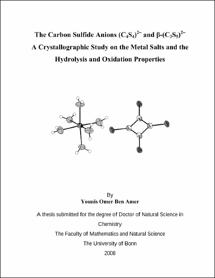The Carbon Sulfide Anions (C4S4)2− and β-(C3S5)2−A Crystallographic Study on the Metal Salts and the Hydrolysis and Oxidation Properties

The Carbon Sulfide Anions (C4S4)2− and β-(C3S5)2−A Crystallographic Study on the Metal Salts and the Hydrolysis and Oxidation Properties

| dc.contributor.advisor | Beck, Johannes | |
| dc.contributor.author | Ben Amer, Younis Omer | |
| dc.date.accessioned | 2020-04-13T21:54:57Z | |
| dc.date.available | 2020-04-13T21:54:57Z | |
| dc.date.issued | 20.02.2009 | |
| dc.identifier.uri | https://hdl.handle.net/20.500.11811/4033 | |
| dc.description.abstract | Tetrathiosquarate (C4S4)2− forms water soluble compounds of salt like character with the earth alkaline ions from Mg2+ to Ba2+. While Ca2+ and Sr2+ yield almost isotypic tetrahydrates M(C4S4)•4 H2O, Mg2+ and Ba2+ show a different behaviour. For Mg2+ the formation of the discrete octahedral complex ions [Mg(H2O)6]2+ is observed. Ba2+ forms a double salt Ba4K2(C4S4)5•16 H2O under inclusion of the potassium ions for the starting compound K2(C4S4)•H2O. In all structures, the (C4S4)2- ions almost fulfil D4h symmetry despite small derivations from the ideal symmetry are generally observed caused by the coordination to the cations. Tetrathiosquarate (C4S4)2- forms water soluble compounds of salt like character also with Mn2+ and Fe2+ ions. In both structures, water molecules are present as ligands and fill the coordination environment of the cations to octahedra. In the iron(II) salt [Fe(H2O)2](C4S4)•4H2O, the Fe2+ ions are coordinated by two H2O ligands and linked by bridging tetrathiosquarate ions to a one-dimensional strand. The Mn(II) salt [Mn4(OH)4(H2O)4](C4S4)2 is made up of cube-shaped complexes [Mn(OH)4(H2O)4]4+, which are connected by tetrathiosquarate ions to a two-dimensional network, in which O–H•••S and O–H•••O bridging bonds connect the layers to a three-dimensional structure. β-(C3S5)2- turned out to be quite sensitive to oxidation, giving at room temperature in aqueous solution the (C6S10)2- ion, which was isolated using Ca2+ and Sr2+ as [Ca(H2O)7](C6S10) and [Sr(H2O)8](C6S10)•H2O. To further study the hydrolysis and oxidation processes, aqueous solutions of the potassium salt of β-(C3S5)2- were brought to crystallization using tetraphenylarsonium chloride, [As(C6H5)4]Cl. By this method, several hydrolysis and oxidation products of β-(C3S5)2- could be trapped as the respective [As(C6H5)4]+ salts. Under air, crystals of [As(C6H5)4]2(C3S5)•2H2O could be isolated and crystals of [As(C6H5)4](HC3S5), containing the monoprotonated form of (C3S5)2-, were found. [As(C6H5)4]2(C3S6O3)•3H2O is the third isolated compound formed under air. The novel (C3S6O3)2- ion is built of a planar C3S5 moiety with a pyramidal SO3 group attached to the outer S atom of the C3S5 group. Under exclusion of air [As(C6H5)4](C3S4H) crystals were formed within few days. The anionic unit derives from (C3S5)2- by a C−S bond cleavage and the substitution of the sulfur atom by a hydrogen atom under formation of a new C−H bond. | en |
| dc.language.iso | eng | |
| dc.rights | In Copyright | |
| dc.rights.uri | http://rightsstatements.org/vocab/InC/1.0/ | |
| dc.subject.ddc | 540 Chemie | |
| dc.title | The Carbon Sulfide Anions (C4S4)2− and β-(C3S5)2− | |
| dc.title.alternative | A Crystallographic Study on the Metal Salts and the Hydrolysis and Oxidation Properties | |
| dc.type | Dissertation oder Habilitation | |
| dc.publisher.name | Universitäts- und Landesbibliothek Bonn | |
| dc.publisher.location | Bonn | |
| dc.rights.accessRights | openAccess | |
| dc.identifier.urn | https://nbn-resolving.org/urn:nbn:de:hbz:5N-16726 | |
| ulbbn.pubtype | Erstveröffentlichung | |
| ulbbnediss.affiliation.name | Rheinische Friedrich-Wilhelms-Universität Bonn | |
| ulbbnediss.affiliation.location | Bonn | |
| ulbbnediss.thesis.level | Dissertation | |
| ulbbnediss.dissID | 1672 | |
| ulbbnediss.date.accepted | 16.02.2009 | |
| ulbbnediss.institute | Mathematisch-Naturwissenschaftliche Fakultät : Fachgruppe Chemie / Institut für Anorganische Chemie | |
| ulbbnediss.fakultaet | Mathematisch-Naturwissenschaftliche Fakultät | |
| dc.contributor.coReferee | Glaum, Robert |
Files in this item
This item appears in the following Collection(s)
-
E-Dissertationen (4305)




